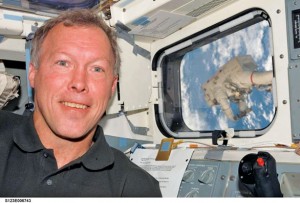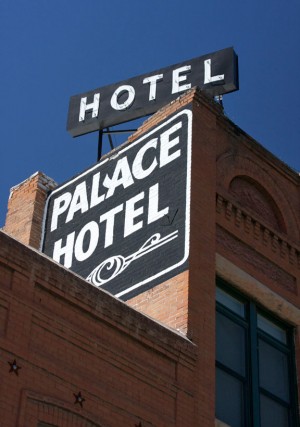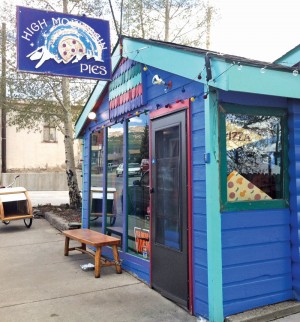by Ann Marie Swan
For retired astronaut Dominic Gorie, the final frontier is some land outside of Salida under an inky silhouette of Mount Shavano.
After a career as a naval aviator, test pilot and veteran of four space shuttle missions, Gorie is building an adobe-style home with his hands alongside his wife, Wendy. It’s a grounding task that Gorie said he finds “physically and mentally challenging.”
Gorie and his wife happened upon Salida while he was assigned to the U.S. Space Command in Colorado Springs from 1992 to 1994. They took their children skiing at Monarch Mountain and soaking at the Salida Hot Springs Aquatic Center. Soon, they fell in love with the Arkansas Valley. But before Gorie could put down roots, he had some space traveling to do.

Traveling takes us to places outside our comfort zones and ourselves, displacing and changing us. While trekking through space, Gorie said he never tired of the wonder of it all.
The launch in itself was dramatic and inspiring. But the stress that astronauts felt can’t be overstated. “You’re sitting on six million pounds of propellant,” Gorie said.
Once safely in space, astronauts got down to business. As two-time commander of the Space Shuttle Endeavour, Gorie said it was “incredible” to fly in formation with the International Space Station. Before docking, the shuttle executed a graceful backflip called a rendezvous pitch maneuver as the space station crew inspected the heat shield on the shuttle’s belly. The mission team would then decide whether the shuttle was safe for re-entry into the Earth’s atmosphere.
This became standard procedure after the Columbia accident in February 2003, which was caused by a damaged heat shield. Gorie’s every action, every move was then intended to dock the grand spaceship in a precise, controlled, careful manner.
As the shuttle moved in, a bell on the space station was rung to honor the crew of the approaching vessel. This lovely tradition is steeped in naval history. The bell was forged from metal on previous spacecraft, including pieces from the Apollo, Gemini and a bolt from the Russian MIR space station. The bolt was originally Gorie’s souvenir from a previous flight.
“It’s beautifully choreographed,” said Gorie, who’s also been a pilot on the Discovery. “Watching the space station flying over the Earth, it’s hard to not be distracted by the beauty. The landing is memorable and rewarding.”
The fast pace of events on orbit was nonstop with very exacting work and tricked-out technology. Up to five spacewalks were scheduled per mission. “Every spacewalk is a huge deal,” Gorie said. “It’s stressful getting in and out of the airlock with hard work for the subsequent seven or eight hours that each spacewalk lasts.” And it’s not easy “any time you’re moving a robotic arm from the space station,” said Gorie, who has logged more than 47 days in space.
Imagine seeing a ding from a rock on your car windshield. This isn’t a big deal but the consequences could be dire in space. On his last flight, Gorie noticed a pit in a window from a micrometeorite that left a splatter pattern. Micrometeorites whiz by at more than five miles per second. Although shuttle windows are a few inches thick, Gorie called mission control. Debris moving at dangerous velocities is just another everyday hazard in space.
Preparing food in space takes some innovation. Gorie strung tomato and sausage slices on dental floss across the space station to prevent lunch from floating away. A celebrity chef could find a niche in space travel because the food is certainly not gourmet now. Gorie called it “not quite as good as airline food.”
It’s nice to enjoy a sweet treat and Gorie liked M&Ms. For kicks, he squirted water from a bag and watched as it formed a perfect circle with a mirror-like surface. Next, Gorie poked an M&M inside the bubble, creating a colorful, round marble that slowly twirled before he gulped it.
Special items from loved ones have journeyed into space. Gorie and his wife exchanged wedding rings, and he took hers with him. He’s traveled with his daughter’s charm bracelet and son’s guitar pick, flying six million miles and adding to their memento wattage. Gorie also took his Bible on every flight.
And those stories about duct tape in space are true. Gorie brought four or five rolls, using most of it for everything from temporary attachments to wrapping trash bags. Tip to future space travelers: don’t launch without duct tape.
Having a good sense of humor is a boon to becoming an astronaut. Gorie recently helped screen astronaut candidates. Sample of criteria: Whose company would you want in a tiny, enclosed area?
A promising end to the astronauts’ workday was an hour with the lights off, gazing at the beauty and mystery of the Earth. During daytime, jewel-like colors of the Caribbean islands and vibrant coral reefs were sublime. At nighttime, the crew admired the brilliance of the world’s city lights, the glow of aurora borealis and the aurora australis, and bouts of lightning. Gorie floated to a window, his body completely relaxed while “watching the show beneath,” he said.
Heartbreak and grief have been part of Gorie’s experience as well. Several crew members killed in the Columbia accident were former classmates. Gorie was assigned to coordinate the recovery, painstakingly searching millions of acres on the ground, piecing together the cause of the tragedy.
Astronauts participate in annual extensive physicals, continuing after retirement. The March 2012 journal Radiology published findings of 27 astronauts with eye abnormalities after being weightless in space. The study’s results suggest weightlessness can squash the eyeballs of astronauts, swell the optic nerves and blur vision. One theory is that increased pressure caused the abnormalities. Without the downward pull of gravity, fluids in the body shift higher, including inside the skull.
Flattening of the eyes could be compensated with glasses, and nearsightedness may improve. But swelling could damage eyesight and lead to blindness. These findings are a concern as potential long-duration space missions, such as to Mars, could take years. Meanwhile, NASA has sent glasses with adjustable, corrective power if astronauts experience vision changes in space.
Dr. Richard Williams, NASA’s chief health and medical officer, wrote in an email that “a minority have had persistent visual acuity changes.”
“The risk of blindness is theoretical at this point,” Williams said. “No astronaut has been disqualified from further space flight due to these issues.”
Williams said he’s seen early onset of cataracts in some astronauts that might be related to space-radiation exposure, but this is uncertain.
Gorie has been a celebrated guest at local schools, captivating kids with his out-of-this-world stories. For the next generation of explorers, scientists, engineers and astronauts, one program to inspire them is in place in Salida. Longfellow Elementary fourth-grade teacher Tami McDonald, who was raised in Salida, was awarded a highly competitive NASA Endeavor fellowship, which started in January 2011. (Note, the fellowship name is not associated with the shuttle, which was named after the historic British ship that ventured to the South Pacific, Australia and New Zealand.) Endeavor fellows interact with NASA scientists to bring relevant discoveries into the classroom.
Students participated in live web chats with the engineer of the Mars rover, Curiosity. Fourth-graders also connected with a wildlife ecologist at NASA who monitors ecosystems after each launch, measuring the fallout of acid rain on fish.
One NASA classroom project focused on air traffic control with distance, rate and time calculations. Another one involved designing and building a rocket to hit a distant target. After becoming a fellow, McDonald said she has higher expectations and goals for the students. “They’re creatively solving their own problems,” McDonald said.
NASA’s 30-year shuttle program ended in July 2011 with the voyage of Atlantis. High-profile space exploration is becoming more of a commercial venture, and this tugs at Gorie’s heart. It’s difficult for Gorie to get his head around the idea of training American astronauts without a vehicle. But the upside of private companies racing to space would be the competition and improvements in technology and design, he said.
“There are all kinds of reasons to do what we do,” Gorie said. “The human experience is one of exploration.”
Salida resident Ann Marie Swan has worked as a daily journalist in Denver, Honolulu and Tokyo. She’s from New Orleans.



